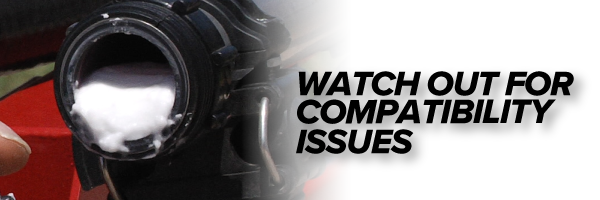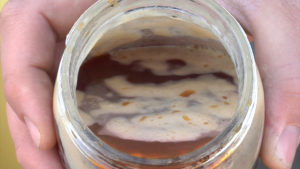By Brian Hefty

By Brian Hefty
I enjoy eating cottage cheese. I don’t enjoy looking at a tankmixing issue where products turn into what looks like cottage cheese in the spray tank. Here are a few quick notes going into this spring so hopefully you will avoid the compatibility issues many of us have faced in the past.
COMPATIBILITY AGENT
Most importantly, and if you get nothing else from this article, please make sure you always have a compatibility agent on your spray truck. There are many products out there, but our favorite is Convert from Precision Labs. The last couple of years this has given us the best results. It can be added to a spray mix before you have a problem or it can be used as soon as you start to see issues forming in your tank. Convert, like most compatibility agents, is NOT labeled with Enlist products or Xtend dicamba herbicides, as the tankmix partners are limited in both Enlist and Xtend. It can however be used with most anything else.
ANYTHING MIXED WITH FERTILIZER
Most products were designed to mix in water, not fertilizer. I’m not saying you can’t mix most everything with fertilizer, but I am saying you need to be careful with this. Plus, each batch of fertilizer seems to be slightly different. I’ve had it many times before where I get a call from a farmer who says something like, “This is my 10th load of fertilizer and every other load mixed fine with my herbicide. This one didn’t.”

Jar testing is an easy way to preview how well your mix will behave in the tank.
JAR TEST
A couple years ago I had a farmer send an e-mail to our radio show, wondering why we even talked about jar testing, because “no one does it”. That’s ridiculous. We always have and always will suggest you do everything on a small scale before you do it on a big scale. Mix a small amount of things together you think could be incompatible. It’s way better to find out in a jar than in a 1200-gallon tank. By the way, you can do this in the spring, a month or two before you want to go spray. That way you find out well in advance of when you actually need the product, and you have time to come up with another solution.
DRY FLOWABLES
Please make sure your dry flowables are fully solubilized. If there are still some dry particles in your solution, that could eventually lead to plugged spray nozzles or screens.
PRE-SLURRY
You may need to pre-slurry whatever you are mixing. For example, if you have 2 different dry flowables you want to put in your spray tank, the first one will mix in the water just fine, but the next one could be a problem. Instead, take that second one and mix it in a container of water before adding it to your spray tank.
CLEAN YOUR SPRAY TANK OFTEN, ESPECIALLY RIGHT AFTER YOU FINISH SPRAYING
The longer you let anything sit in your spray tank, the greater chance the water disappears from whatever solids are left, leaving residue you don’t want in your tank, boom, screens, and nozzles. I know cleaning your spray tank takes some work, but at least flush your tank with water on a regular basis if you don’t clean it every time. Anything will help.
ENLIST ONE AND ROUNDUP
Ever since the K-salt, 6-pound glyphosates (PowerMAX, WeatherMAX, and RT3) came out, we have seen compatibility issues with 2,4-D. Usually, this isn’t a big deal if there is LOTS of water in the tank prior to adding the herbicides, and they are added slowly one at a time, but going into 2020 there will be a tremendous amount of glyphosate mixed with Enlist One (2,4-D-choline) on Enlist crops, so we are concerned. We have already had a few farmers who have had plugged spray nozzles and screens, so be careful with this combination. You should be OK if you add the Roundup last after the spray tank is almost full, and make sure you are agitating at a moderate pace. If you are using an inductor, just make sure you have flushed your inductor very well with water before dumping in Roundup.
INSECTICIDE IN-FURROW
Don’t use generic bifenthrin together with fertilizer. You need a separate delivery system, as most generics are incompatible with fertilizer. Otherwise, use name brand Capture LFR. The LFR stands for liquid fertilizer ready, and it does mix well with most starter fertilizers.
FUNGICIDE IN-FURROW
Using a fungicide in-furrow in corn or soybeans has been a popular thing in the last few years, and we’ve seen it pay pretty well when planting super-early into cold soils. The problem is that fungicide not in a whole bunch of water doesn’t mix well with either fertilizer or insecticide. If you want to use a fungicide in-furrow, either use a separate delivery system or buy Temitry LFR (premix of Capture LFR and Headline), as it will mix with fertilizer, and it already contains an insecticide.
TALK TO YOUR AGRONOMIST
Our agronomists can usually tell you if certain products are compatible with others or not. However, there are always fluke situations, so keep an eye on your spray tank, screens, and nozzles all the time.
